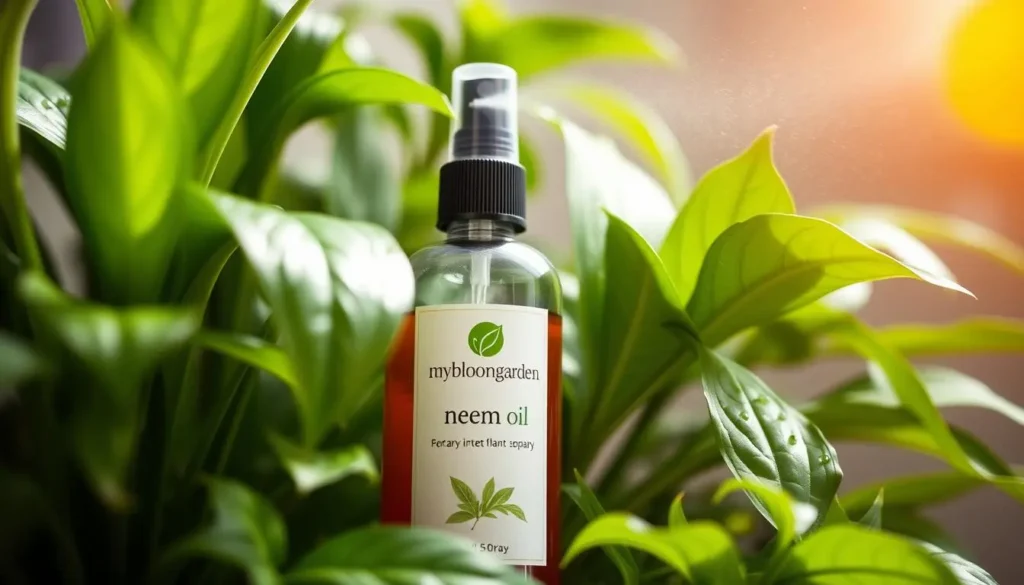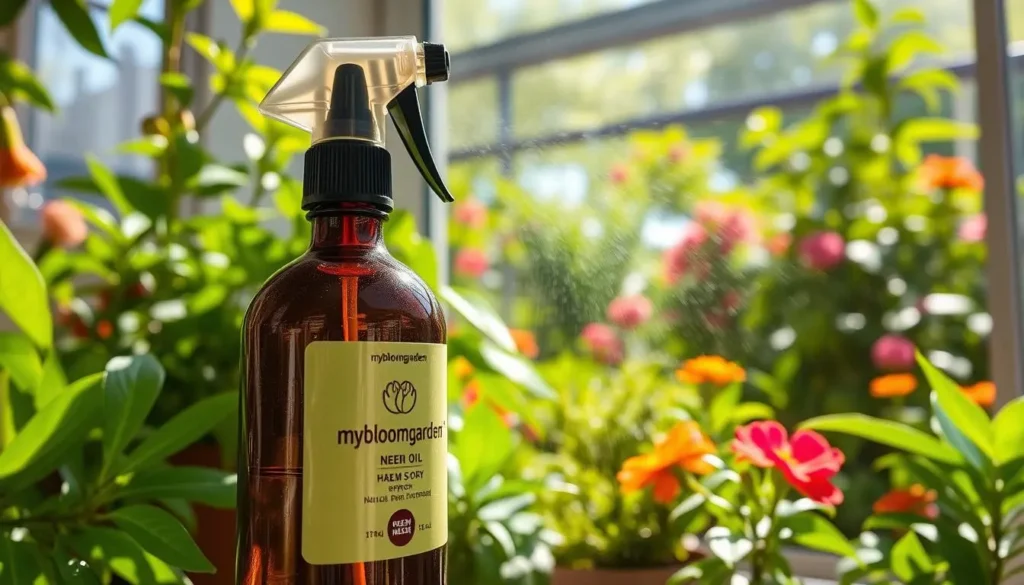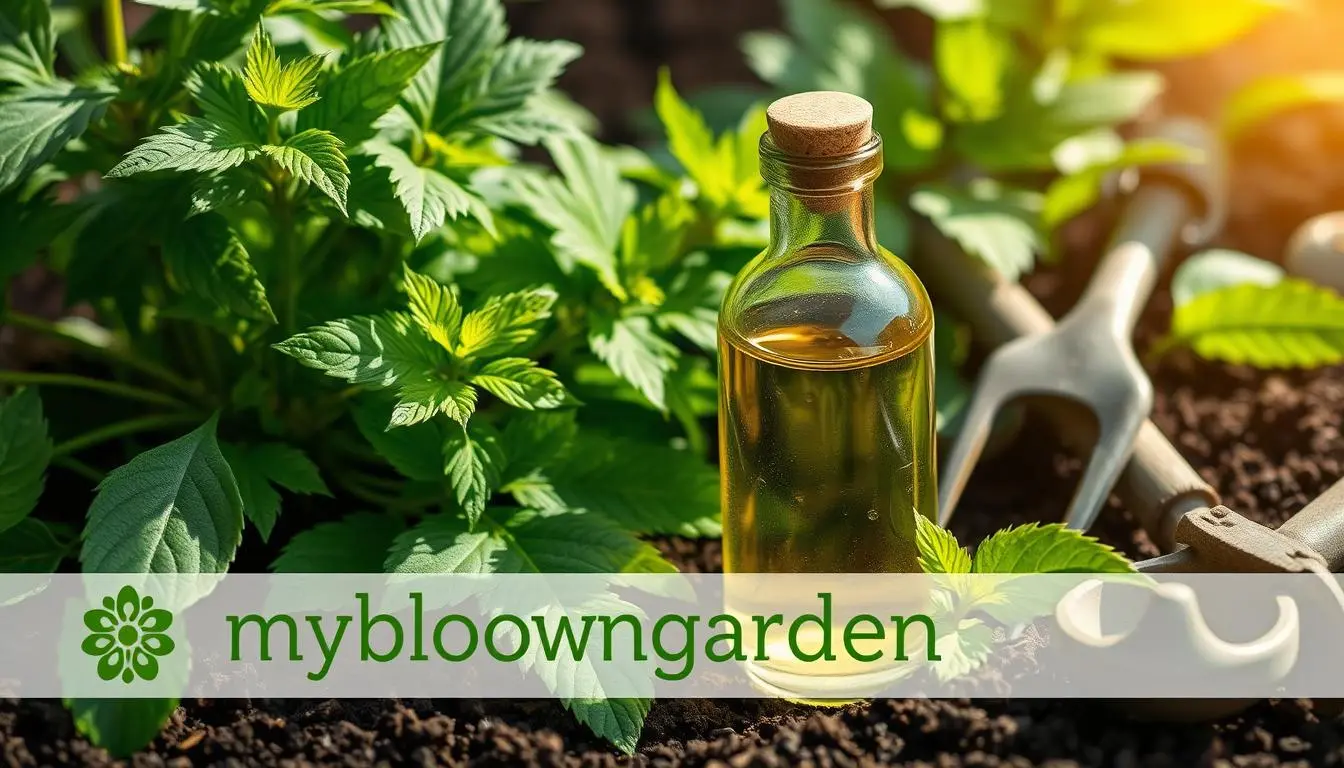I love gardening and believe in nature’s power to solve our plant care problems. That’s why I’m excited to share neem oil’s amazing benefits. It’s a natural way to keep your garden healthy and free from pests and diseases.
In this guide, we’ll explore neem oil’s origins, makeup, and uses. You’ll learn how to use it in your plant care routine. This guide is for everyone, whether you’re new to gardening or have years of experience. It will help you keep your plants healthy with a natural and green approach.
Table of Contents
Understanding What Neem Oil Is and Its Natural Origins
Neem oil comes from the seeds of the neem tree (Azadirachta indica). This tree is found in the Indian subcontinent. For centuries, people have used neem oil in traditional medicine and gardening. It helps control pests and diseases in plants.
Chemical Composition of Neem Oil
The main ingredient in neem oil is azadirachtin. It’s very good at killing insects. The oil also has nimbin, nimbidin, and fatty acids. These help it work well as a natural pesticide.
How Neem Oil is Extracted
Neem oil is made from the seeds using cold-pressing or mechanical methods. This keeps the oil’s natural compounds in balance. It makes the oil strong and effective for neem oil for plants and garden practice.
Different Types of Neem Oil Products
- Cold-pressed neem oil: This is the purest form, with the most active ingredients.
- Refined neem oil: It’s processed more to be stable and less smelly.
- Neem oil emulsions: These mix neem oil with water and other stuff. They’re easy to use on plants.
Every type of neem oil is great for fighting pests and diseases in gardens. It’s a natural choice for gardeners who care about the environment.
Benefits of Using Neem Oil for Plants
Neem oil is a natural wonder for plant care. It’s great for organic gardening because it offers many benefits. It controls pests and boosts plant health, making it a key tool in gardening.
Neem oil is a strong natural pesticide. It stops pests like aphids, mites, and whiteflies from reproducing and feeding. This makes it a safe and effective way to fight infestations.
Neem oil also fights fungal diseases. It prevents issues like powdery mildew and black spot. Using neem oil keeps your plants healthy and looking good.
“Neem oil is a natural and effective way to keep your plants thriving, without relying on harsh chemicals.”
Neem oil is also good against mites. It tackles multiple pest and disease problems with one solution. This makes it a versatile choice for gardeners.
Neem oil boosts plant health and strength. It helps plants fight off pests and diseases better. This natural approach helps your garden grow strong and healthy.
As an organic gardener, you’ll love neem oil. It’s a green alternative to harsh chemicals. Using neem oil helps your plants stay healthy and supports a sustainable garden.
How to Mix Neem Oil for Effective Plant Treatment
Making a neem oil solution for your plants is easy. Just follow a few steps to make a strong mix. This mix will protect your plants from pests and diseases. Let’s look at the tools and methods for mixing neem oil well.
Essential Mixing Tools and Materials
To mix neem oil, you need a few basic things:
- A clean spray bottle or container
- A measuring cup or spoon
- Neem oil
- Distilled or purified water
- A mixing tool, such as a spoon or a small whisk
Make sure all your tools are clean and dry before mixing.
Proper Neem Oil to Water Ratio
The best neem oil to water ratio is 1:50 or 2:100. This means for every 1 part of neem oil, use 50 parts of water. For example, 1 tablespoon of neem oil needs 50 tablespoons (about 3 cups) of water.
Safety Precautions During Mixing
When mixing neem oil, be careful:
- Wear gloves to protect your hands from the oil
- Work in a well-ventilated area to avoid inhaling the fumes
- Avoid splashing the solution on your skin or eyes
- Wash your hands thoroughly after mixing the neem oil solution
By following these steps, you can make a safe and effective neem oil mix for your plants.
Success comes from finding the right neem oil to water ratio and being careful. With a bit of care, you can make a strong natural pest control for your garden.
Common Plant Pests and Diseases Controlled by Neem Oil
Neem oil is a natural pesticide that fights many plant pests and diseases. It works by stopping pests from eating, mating, and laying eggs. This helps keep your garden healthy and strong. Learn how to use neem oil for plants to keep your garden in top shape.
Neem oil is great at killing pests like aphids, mealybugs, and spider mites. It makes it hard for them to survive. This makes it a key part of garden practice for keeping pests away.
Neem oil also fights fungal diseases like powdery mildew and black spot. It covers the plants, making it hard for fungi to grow. This keeps your plants safe from many diseases.
Neem oil can even fight some bacterial and viral diseases. It stops bacteria that cause leaf spot and wilt. It also helps against some viruses that harm plants.
Using neem oil in your garden practice helps fight pests and diseases. This keeps your plants healthy and your garden thriving. It’s a natural way to care for your garden.
Best Practices for Applying Neem Oil for Plants
Using neem oil right is key to keeping your plants healthy. Here are some tips to make sure your plants get the most from this natural pest fighter:
Optimal Application Times
The best time to use neem oil is early morning or late evening. This avoids the sun’s strong rays. It also lets the oil soak into the plant better.
Coverage Techniques
- Use a fine mist spray to cover the whole plant. This includes the underside of leaves where pests hide.
- Apply the neem oil spray to areas most at risk. This includes new growth and leaves that are easy for pests to get to.
- Make sure to mix the neem oil as the maker says. This ensures it’s right for covering the plant well.
Weather Considerations
Don’t spray neem oil on hot, sunny, or windy days. The oil might evaporate too fast. Also, wait a few hours if it’s going to rain. Neem oil needs time to dry and soak into the plant. The best weather is mild and cloudy with little wind.
By following these tips for using neem oil spray for plants, you can keep your plants healthy. They will grow strong and stay pest-free.
When and How Often to Spray Neem Oil
Figuring out when to spray neem oil on your plants is key for keeping pests away and keeping your plants healthy. The right time to spray depends on the pests you’re fighting, how big your plants are, and the weather where you live.
Usually, spray neem oil every 7-14 days when your plants are growing. This keeps pests like aphids, spider mites, and whiteflies at bay. If pests are really bad, you might need to spray every 5-7 days until they’re gone.
When treating pests, make sure to cover all parts of the plant, including the underside of leaves. Spray again as needed, usually every 3-7 days, until pests disappear.
Neem oil works best when used before pests become a big problem. Regular spraying helps keep pests away and prevents them from causing more harm.

“Consistent, preventive applications of neem oil can significantly reduce the need for more intensive pest control measures down the line.”
Keep in mind, you might need to change how often you spray neem oil based on weather, temperature, and the pests you’re dealing with. Always watch your plants closely and adjust your spray schedule as needed.
Potential Risks and Plant Sensitivity to Neem Oil
Neem oil is often seen as a safe, natural way to protect plants. But, it’s key to know about possible risks and how plants might react. Using too much or applying it wrong can cause problems. So, gardeners need to be careful when using it.
Signs of Neem Oil Damage
Using too much neem oil can harm plants. This can lead to:
- Leaf discoloration or yellowing
- Stunted growth or wilting
- Damage to delicate plant tissues
- Increased susceptibility to other pests and diseases
Plants to Avoid Treating
Not every plant does well with neem oil. Some are more sensitive and can get damaged, like:
- Succulents and cacti
- Delicate ornamental plants with thin leaves
- Certain herbs like basil and mint
- Flowering plants during their blooming period
Always test neem oil on a small area first. This way, you can see if there are any issues before treating the whole plant or garden.
Knowing the risks and being careful with plant sensitivity helps gardeners use neem oil safely. This way, they can keep their gardens healthy and thriving.
Indoor vs Outdoor Neem Oil Applications
Using neem oil for plant care can differ based on whether plants are indoors or outdoors. Neem oil is great for fighting pests and diseases. But, there are important things to think about for each setting.
For indoor plants, you might need to use less neem oil. Indoor spaces are smaller, so a weaker mix works well. Also, check if your indoor plants can handle neem oil. Always test a small area first.
Outdoor plants, however, might need more neem oil. This is because of wind, rain, and sun. Spray the underside of leaves to reach pests. Reapply after rain or watering to keep it working.
You can also add neem oil to plants growing in water. This includes hydroponics or aquaponics. Just make sure to mix it right to avoid harming your plants or water life.
“Neem oil is a versatile natural pest control solution that can be used effectively for both indoor and outdoor plants, with a few adjustments to the application method and concentration.”
Knowing how to use neem oil spray for plants in different places helps them stay healthy. This is true whether they’re indoors or outdoors.

Storage and Shelf Life of Neem Oil Solutions
Storing your neem oil mixture or spray right is key to keeping it effective. Knowing the best storage spots and how to spot spoilage is crucial.
Proper Storage Conditions
Store your neem oil in a cool, dark spot. The best temperature is between 40-80°F (4-27°C). Heat or UV light can damage the neem oil’s active compounds.
Use airtight, opaque containers like amber glass or BPA-free plastic. This keeps the neem oil safe from air and light, which can harm it over time.
Signs of Spoilage
Here are signs your neem oil might have spoiled:
- Changes in color or clarity – Fresh neem oil is clear to light amber. If it’s discolored or cloudy, it’s gone bad.
- Unpleasant odor – Good neem oil smells slightly nutty or garlicky. A bad smell means it’s spoiled.
- Separation of layers – A well-mixed neem oil solution stays uniform. If it separates, throw it out.
By following the right storage tips and checking your neem oil, you’ll get the most out of these natural solutions.
Conclusion
In this guide, we’ve looked at the great benefits of using neem oil for plants. It’s a natural way to keep pests away. You now know how to mix, apply, and store neem oil solutions for your garden practice.
Neem oil fights off many pests and diseases. It keeps your garden healthy and strong. Just remember to use it safely and carefully to get the best results.
Neem oil is a key tool for green gardening. It helps you keep your garden pest-free and full of life. With what you’ve learned, you can use nature’s power to make your garden even better.

